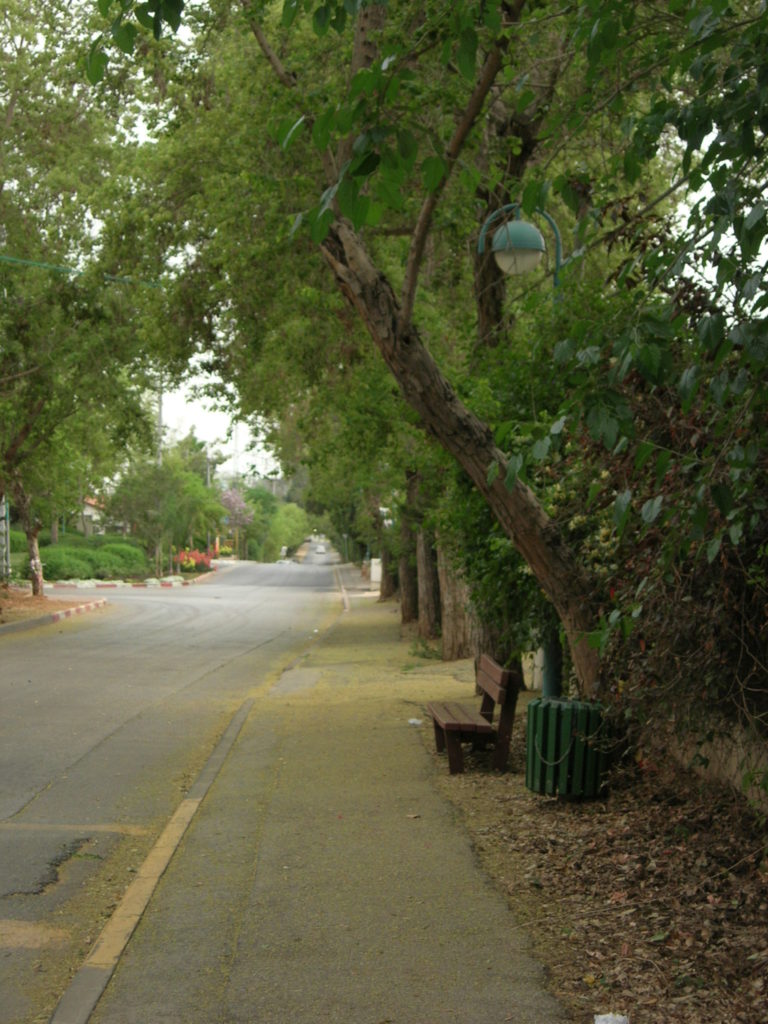Under the shade of a young Blue Jacaranda tree; still leafless (in early spring the tree is only covered with purple flowers), whose height did not exceed 13 feet (4 meters) and its top radius was approximately 9 feet (3 meters); were crowded on a sweltering hot mid-May day, no less than six vehicles. One of them- a large Jeep, four family sedans and a small vehicle. This was the picture in a countryside supermarket parking lot. Except for that tired Jacaranda tree there was no other shade to be found for the shoppers in the air-conditioned store. The six vehicles seemed to be combating over every bit of shade, and if they could move on their own they would surely push each other aside in an attempt to get some more shade. Meanwhile, the other vehicles stood in the scorching sun, groaning under the heat load.
It reminded me of many other such sights – the train station parking lots, the university parking lot, and many side street parking lots , all burning in the summer sun. All shade less.
When it’s hot, people crave shade. It is as welcoming as an air-conditioned room. Clearly many would willingly pay for a shaded spot. Why then is shade not offered? Why do we not get to walk in the shade, shop in the shade, stand at the shaded traffic lights, at the crosswalk, in line for the bus, especially in hot areas where the sun is scorching almost year round?
Shade can be “produced” in various ways by adding nets, tarps, or other shading materials over the streets. Underground parking lots and stations or even underground streets (providing access under the first floor of a building- often used in cold climates to escape the snow) – are just a few ideas., However, planting trees has the most significant impact on the environment, and even more so in an urban environment. Many studies of trees and their impact on shade and the environment can be found such as those of Prof. Oded Pochter, Prof. Hadas Saaroni, and Prof. Arie Bitan of Tel Aviv University (bioclimatology – see source).
Trees contribute significantly to cooling the city or lowering the temperature in their environment. By shading the urban areas they improve comfort and walkability. Tree shade increases humidity in the air ( less evaporation as temps are lower), contributes to filtering pollutants from the air and creates a green and pleasant-looking environment. Taller trees with dense leaves produce significantly more shade and provides a pleasant environment for those who use it.
Trees serve as an essential resource in urban living. Parks with trees contribute to cooling the area by 3-4 degrees. People tend to congregate under them especially on warm days. These type of days are ever increasing due to global warming, so trees and the shade they provide are key to urban daily comfort. Trees protect the soil from eroding or being swept away. A standing tree increases rainwater filtration to the soil (preventing surface runoff). This in turn improves the soil itself by washing pollutants and accumulating groundwater. Trees also produce a more balanced ecological environment. They provide nesting space for birds, who then contribute to reducing harmful insects (cockroaches, flies and mosquitoes). Trees can also provide food for birds, squirrels, chipmunks, insects and more. In many cities around the world, along with city parks, vegetable and fruit gardens are being developed. Residents can then access these public orchards of fruit trees or vegetable gardens for recreation and their calming upkeep.
Trees absorb a significant portion of CO2 greenhouse gas from the atmosphere in their leaves. Global evidence of this is shown in the dramatic fluctuations of CO2 concentration in the air between summer and winter. Most of the world’s trees are located north of the equator, which is also where most of the most of the earth’s land is located. In the winter season, most trees are bare, so there is an increase of CO2 concentration in the atmosphere. In contrast, the summer season, when trees’ foliage blooms, CO2 concentration drops, because it is absorbed by the leaves.
So we can conclude that trees are an asset. Why then do we not plant thousands of trees every year?
I guess there are many reasons for this, ranging from ignorance on the subject -my neighbors told me that a concrete yard is more pleasant than their trees, to the resources that trees require – Trees consume water all year round, which requires irrigation, they require pruning so as not to become dangerous to electrical wires, trees can also create waste such as branches, falling leaves, bird feces and finally trees can attract animals such as bats, mice and snakes.
As always, it comes down to a cost versus benefit analysis. In my opinion, the value of trees immeasurably outweighs their cost especially when comparing them to other shading methods. A shade net, canopies (pergolas) or awning does not have the same effect as a tree. Under canopies, a greenhouse effect may be created that will actually increase people’s discomfort and raise temperatures. Mesh is more airy, but does not create the significant shade a tall tree does. We must also consider the tree’s ability filter the air, increase moisture and absorb carbon dioxide, properties that do not exist in other shading methods, good as they may be.
Therefore, it is important to combine several elements of shading in the public space. I am sure that the appearance of many trees in parking lots, city streets, gardens, parks, crossings and near bus stops, will significantly improve the quality of life in urban space and in general, and together with combining technologies of irrigation using gray water, planting trees will be easy, cheap and affordable in every way.








